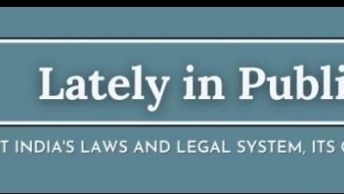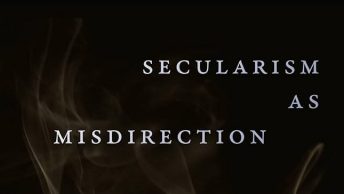India’s and Australia’s different experiences in the British Commonwealth revolved around race: British India and White Australia were based on race ideologies that justified forms fo colonialism and exclusion. (p 234)
This month, Law and Other Things celebrates its fifteenth anniversary. This blog’s analysis of the laws and legal system of contemporary India has necessarily called for frequent consideration of the long shadow cast by colonial rule over India’s legal culture, legal institutions and the relationship between the people of India and the state (including the pervasive impulse towards classification and surveillance). In this post, as part of that anniversary, I review a book which casts new light on some of these questions from an unusual angle.
Kama Maclean is Professor of South Asian and World History at the University of New South Wales. Her excellent new book, British India, White Australia: Overseas Indians, intercolonial relations and the empire (2020) examines this imperial legacy and the divergent histories of colonialism in Australia and India through the lens of the relationship between both countries. As Maclean pithily explains, ‘[t]his is a book about an awkward triangular dynamic that developed between Britain, India and Australia in the early twentieth century, and some of the people who got caught up in it’ (p 1). This ‘dynamic’ has many facets: early diplomatic relations between the two countries (explored in chapter 7) and debates about India’s status and standing within the Empire and early Commonwealth (chapter 5); the lives of Indians in Australia before and after Federation, particularly as Australia’s exclusivist, racist ‘White Australia’ immigration policy became increasing fixated upon preventing new arrivals and on limiting opportunities for those already present (explored throughout, but particularly in chapters 1 and 2); and through how both nations were perceived in the cultural imaginary of the other – how Indians saw Australia and how Australians saw India, as expressed through journalism, fiction, photos and even cartoons and advertising.
Australia’s role in this ‘awkward triangular dynamic’ was inevitably inflected by its own experiences of settler colonialism and the dispossession and exclusion of Indigenous Australians, and indeed by a refusal to recognise the limits of those experiences. Maclean acidly remarks on the often-awkward history of bilateral Australia-India relations that ‘[t]oo often, Australian policymakers have presumed that Australian and Indian experiences of empire were essentially the same’ (p 232). The imagined “White Australia” of policy-makers, the press and popular sentiment was incapable of being falsified – it was reaffirmed both by a perceived lack of ‘civilisation’ in India and by the perception that Indians, once ‘civilised’, ‘might compete with, and indeed exceed, the abilities of Australians’ (p 28). Exclusionary laws could not be separated from social practices. Restrictions upon employment drove Indians in Australia after Federation into iterant employment, often as hawkers; Maclean chronicles the lives of Indians on the margins of early-twentieth century Australian society through both contemporary accounts and through close textual and visual analysis of photographs. “Certificates of Exemption from the Dictation Tests” (CEDTs), issued to ‘aliens’ resident in Australia before 1901, frequently record (and to that extent bestow) the informal and potentially derogatory first name ‘Charlie’. CEDTs were issued as part of a racist immigration policy and, by recording and declaring new names and racial ‘categories’ for their holders, served as a means by which that policy was enforced and maintained.
Australia’s part in all this was not part of mere subservience to British rule. Indeed, Maclean’s book records repeated instances in which the United Kingdom – the third partner in the ‘awkward triangle’ – attempted, often feebly, to restrain racially-exclusionary measures by the Australian government. Even though “White Australia” understood its heritage to be British, and even though its supporters’ protestations of white supremacy often involved appeals to British achievements and military superiority, the colonial project in Australia outlasted and outstripped the era of direct control from London.
There are obvious parallels between these forms of maintaining colonial ‘difference’ and control with current Indian legal and social debates. The collection and ‘classification’ of data continues to be used as a mechanism for the identification and control of subaltern communities – as through the ‘surveillance of authenticity’ involved in the NRC process, or the arbitrary and discriminatory categorisation of groups deserving of protection under the Citizenship Amendment Act. Arbitrary distinctions continue to be drawn as to which groups are ‘more Indian’ than others. Legal and political discrimination continue to feed, and to be fed by, bigotry in the media and cultural spheres. The “White Australia” policy is dead. But in both India and Australia, the relationship between citizens and the state, and within the populace itself, continues to be shaped by how both countries were perceived and governed by the colonising power, and by the lasting impact (and adoption) of those technologies of control.
This is an outstanding book. It is exhaustively researched. Its prose is a model of clarity, precision and unexpected wit, addressing a myriad of topics (ranging from political developments to boot polish ads of the First World War) with verve and authority. It assumes relatively little knowledge of either Australian or Indian culture or politics in the relevant period; even to a new reader it would present a compelling story of two very different nations and the role that ideologies of white supremacy and ‘colonial liberalism’ played in both. Fascinating figures emerge: the communist activist Clarrie Hart Campbell, who agitated for the rights of Indian seamen and for famine relief in Bengal; Sir Raghunath Paranjpye, the first Indian High Commissioner to Australia, who became increasingly assertive and vocal as India neared Independence; and “Chunder Loo”, a caricature of the loyal, dependable (and subservient) Indian used to sell Cobra Boot Polish for more than a decade, who is now solely remembered as the origin of a vulgar Australian slang term. This book reveals new and important facets of the colonial history of both Australia and India.






Thank you for your sharing. I am worried that I lack creative ideas. It is your article that makes me full of hope. Thank you. But, I have a question, can you help me?